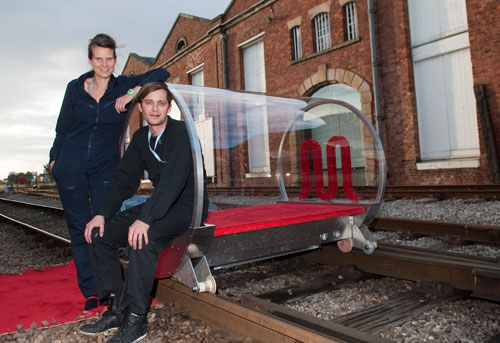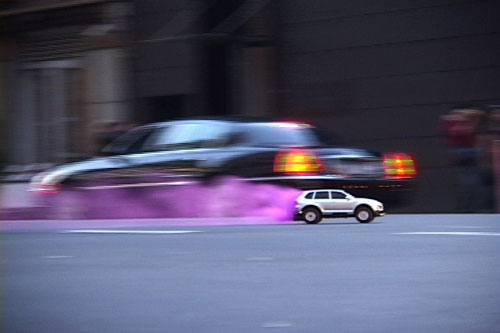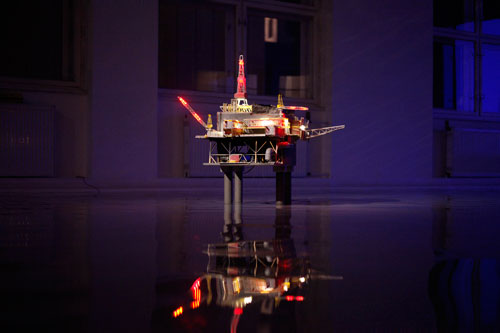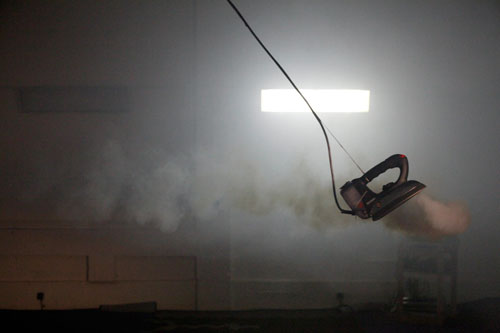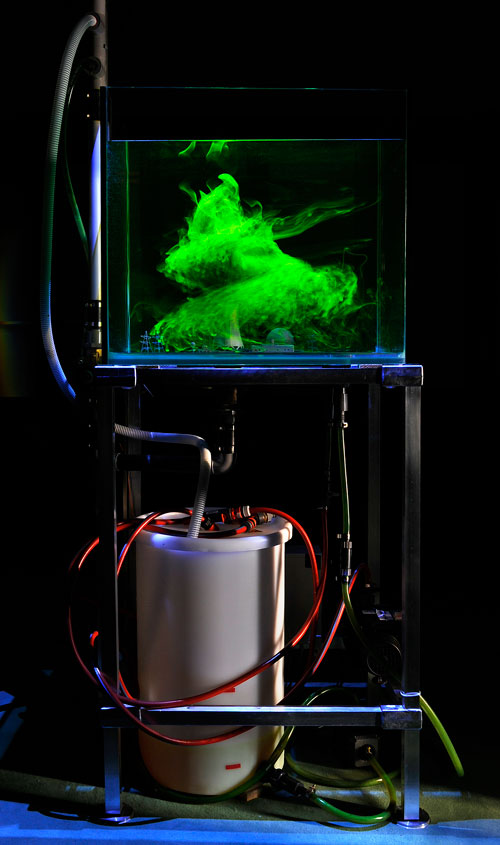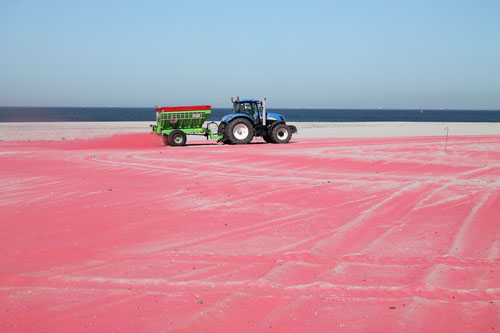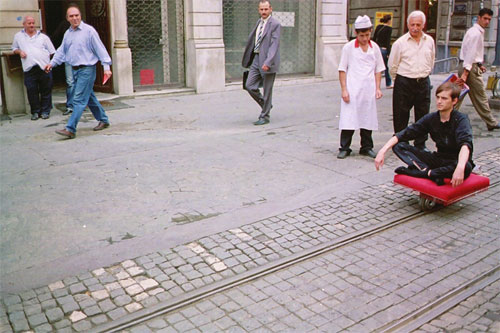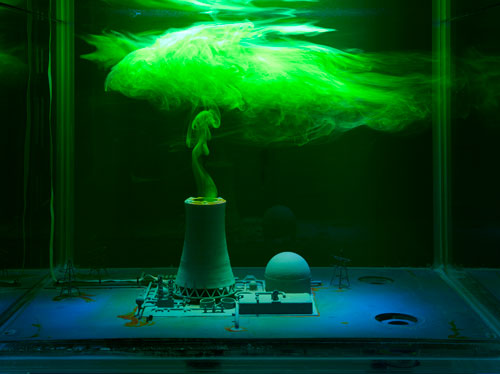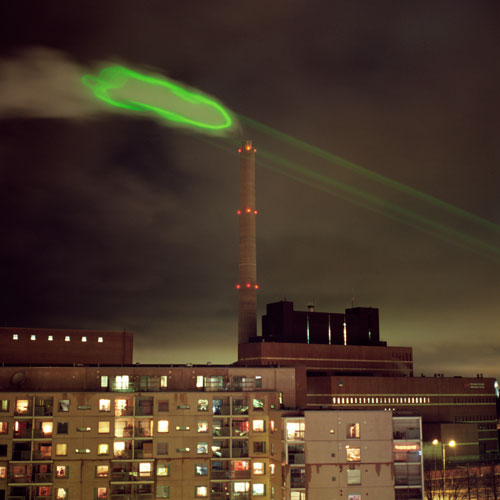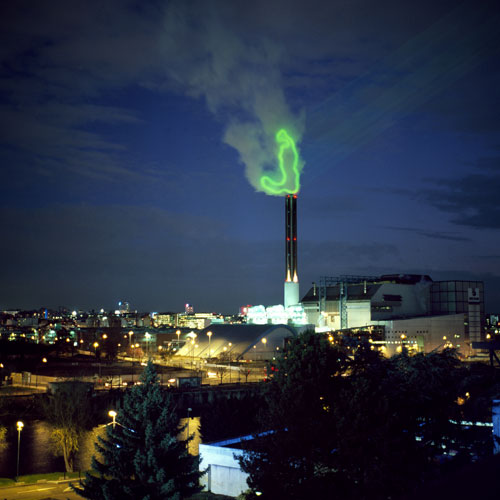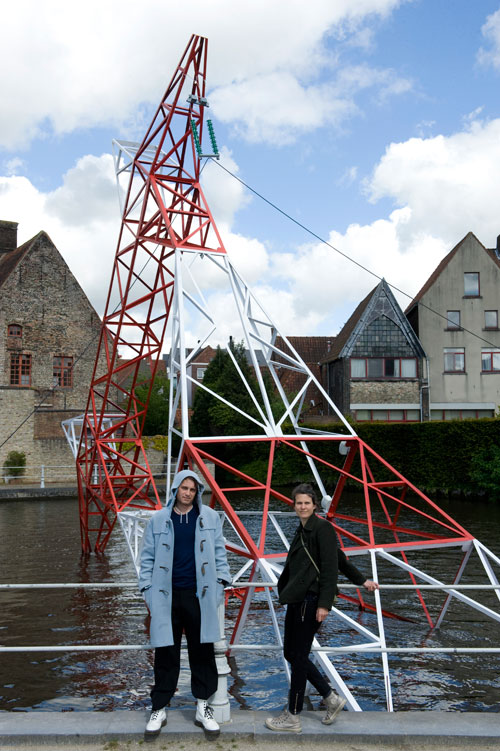

by ANNA McNAY
Man-made clouds, flying carpets and a broken electricity pylon: French-based artistic duo HeHe, comprising British-born Helen Evans (b1972) and German-born Heiko Hansen (b1970), make work focusing on the environment and urban space. Their large-scale interventions are often controversial, but, despite the serious issues being addressed, there is an element of fun to many of them, and a certain aesthetic beauty to others. HeHe were invited to take part in this year’s Bruges Triennial, for which they produced a new work, Undercurrent (2015), which incorporates sculpture, installation, sound and light. Studio International spoke to Helen Evans about this and other projects.
Anna McNay: Where and when was HeHe born?
Helen Evans: We met at the Royal College of Art in the computer-related design department (now Design Interactions) and began working together. When we left, we continued to collaborate. That was around 2000-01. The name obviously comes from combining the first two letters of mine and Heiko’s first names.
AMc: You’re often referred to as a collective, but HeHe is just the two of you, isn’t it?
HE: Yes, I don’t know why people call us a collective, really. It’s just Heiko and me, but we do collaborate with other people occasionally, when we need particular expertise.
AMc: What made you want to become part of an artistic duo?
HE: I come from a theatre background, working in set design, so I’m used to collaborating. Heiko comes from an industrial design background, so it’s similar for him. We like the dialogue. I think it’s very healthy to challenge ideas and build on them together. We've been doing it for so long now it becomes easier and more natural all the time. We don’t really adhere to the concept of an artist as sole author of a work. We like to experiment and learn about new ways of working.
AMc: What are the issues that you try to deal with in your work? What is your starting point, or your core belief, if you like?
HE: A lot of our work is about the environment and urban space. We’re interested in people’s interaction with the urban environment: the way that we’re immersed in consumer and industrial culture and how these forms carry with them certain value judgments. We’re concerned by the contradictions between our beliefs and our actions, and the way that we’re all immersed in this culture while knowing that there are fundamental problems with it. We’re interested in how we can give form to these problems, playing with the aesthetics of environmentalism.
AMc: Can you explain what you mean by the artistic process of “reverse cultural engineering”, a term that comes up a few times on your website, in relation to your work?
HE: There are a lot of people who have been interested in reverse engineering, which is a practice that we also use, taking technologies apart, understanding how they work and rebuilding them, altering and hacking them. That’s something we do in our creative practice. We’re also interested in cultural engineering, so thinking about the ways in which technologies have been developed historically and the ways in which they’ve evolved over time.
The Train project (2003 onwards) is where we really started using this phrase. It involves going back and looking at the way in which trains evolved in the 18th and 19th centuries, when it wasn’t yet quite clear how technology would develop. At that time, they were putting individual cars – privately owned vehicles – on to the public railway tracks. Reverse cultural engineering is about going back to a moment in time and imagining that that path, which wasn’t taken, could be picked up again and taken for future directions. That’s why we make individual vehicles for railway infrastructures. We’ve made a miniature two-person metro system for Paris and a little carpet for Istanbul and a little chair for New York. We have different vehicles for different cities. Reverse cultural engineering is about looking at history and taking up paths not taken and reinventing them. As well as dissecting technologies, it’s about dissecting culture.
AMc: So it’s got a serious message, but there’s quite a fun element to it, too – for example, with the carpets.
HE: Yes. They’re fully functioning prototypes. They’re not meant as solutions, but they are fun. They make people smile, so that’s good.
AMc: What sort of wider response do you get to works like that?
HE: People don’t know quite where to place them. For example, we were operating our little metro station yesterday in Paris and people thought we we’re working for the railway company. We always like to work with realism, but to create this fiction. We think that art is better placed out in the public space and we create an imaginary space where we open up the possibilities. Art in a gallery can be boring.
AMc: Do you believe that artists have a role to play in bringing about social change?
HE: Yes, as much as everybody else. We can all play a role with our everyday microactions – and our bigger actions. Artists have just as much responsibility as anybody else. We’re all individuals: it doesn’t really matter what our job is.
AMc: But, for example, Nuage Vert (Green Cloud) (2008) did bring about a real response from the public in Helsinki and a positive change in that it drew attention to energy usage in the city and there was an ensuing reduction.
HE: There was during the event, yes. I think to tackle energy issues, you have to really attack the problem head-on in a way that is maybe not so acceptable to those with vested interests. That project was very successful there and we managed to realise it with the consent of the authorities, whereas, when we tried to do it in Paris the following year, we were faced with all kinds of censorship and political blockage because the people responsible for the emissions – in other words, the factory operators and the local council – don’t want attention drawn to the smoke coming out of chimneys. We think it’s interesting to push to the limit and try to make people look at the things they don’t necessarily want to see, even though that sometimes brings us problems and risks things not being able to be realised.
AMc: Have you had problems with other projects, as well? Are there more that you have not been able to realise?
HE: Yes. We’ve just done a project in Strasbourg, where we were invited to put something into a department store window. We did a piece about the police, playing on the codes of police signs. The department store decided this wasn’t the kind of thing that should be displayed in a luxury display window after all and shut it down.
AMc: Goodness! Do you ever have to modify your ideas in the process because of objections?
HE: Well, the store asked us to in this instance, but we said we’d rather take the whole thing down than modify it. Otherwise, it becomes a compromise. It depends on the specifics of the project, of course, but, in this particular case, we felt it was unnecessary on the store’s part.
AMc: Do your works have a message to them?
HE: No, they don’t. That’s why it’s interesting that the department store decided that this piece was too provocative. We don’t have any literal message at all. It’s very much up to people to project their meanings on to the work. That’s what happened, for example, with Nuage Vert in Helsinki. It became a positive message for the residents and left a positive imprint in people’s memories. In Paris, people were absolutely terrified about what this art project might do and started panicking. It provoked fear. People project all kinds of things on to artworks.
AMc: Are your projects usually responses to commissions, or do you come up with an idea and then try to find somewhere to place it?
HE: Both. For example, the Train project and the Nuage Vert project were both self-initiated, but then people come to us and ask us to develop something for a specific site and we do respond to specific sites – that’s what really excites us: going to a new place and trying to find a way to embed something into the city. For example, we did a project in Rotterdam (Roduin (Redune), 2012) where we covered a section of beach in red sand and then filmed the way it disappeared. And then in Bruges, for the triennial, they invited us to respond to the city.
AMc: Let’s talk a bit about your work for Bruges, Undercurrent (2015). In what way was it responding to the location?
HE: Bruges is such a protected city. It’s a bit like a Disneyland really – packed with tourists in the day, with its wonderful medieval architecture, and then, at night, they all disappear and it becomes a very sleepy town. It’s very picturesque. The brief of the triennial was to consider what might happen if all these tourists were to stay in the city and Bruges were to become a contemporary metropolis. Well, metropolises have infrastructures – they need energy, they need transport – and we are interested in these kinds of issues around infrastructures and transportation and energy consumption. We had the idea that an electricity pylon that had fallen into the water might create quite a dangerous situation (although the artwork is, of course, quite safe). The more energy we consume, the more pylons we need. It’s an old technology that hasn’t really changed in 120-odd years. Pylons are quite beautiful structures in themselves. They’re built to be strong and to withstand very strong winds. They’re like little angels who work very hard for us as we go about our daily lives. This one has fallen into the canal, so it’s like a fallen angel.
We like the idea of bringing these structures, which are usually invisible, into the centre of the city so that we can look at them, and look at them in different ways. What we didn’t initially intend, but actually quite like, is that this submerged pylon looks at first like a work of modern art, a painted steel structure, and it’s only as you get closer that you realise it’s a pylon. We like the way it works on these multiple levels. We wanted it to be as big as possible – obviously we were constrained by budget restrictions – and behind it you can see the cathedral of Bruges, which houses a very famous Michelangelo, and there are lots of beautiful medieval buildings. This structure in the foreground stands in contrast to the landscape behind it.
AMc: It’s quite curious because you’ve got the little tourist boats going up to it on their city tours and no one’s really quite sure what it is and if it’s really a pylon, especially with the electrical hissing and crackling and the flashing surges of light.
HE: Yes, those sound and light elements are there to reinforce the idea that it’s a real pylon that might really be carrying high tension electricity. That’s why it’s called Undercurrent, because, of course, current is a term for energy flow, as well as for water. The lights are really there for people at night – just to have an eerie presence.
AMc: How do you go about producing something like that? Do you start off with sketches?
HE: We started off with a proposal, with an image, and we didn’t know exactly where it should be installed in the city. We had a couple of potential sites. We started off by making photographic renderings of what it might look like, just really to communicate the atmosphere we hoped to create. The next problem was trying to think about how we could construct this thing: whether we could find a readymade pylon, whether it’s possible to buy pylons, or a section of a pylon, or whether we’d have to build it ourselves. This period of research also coincided with thinking about where it could be placed and whether it was going to be floating, or on the base of the canal. The problem with Bruges’ canals is that they’re very muddy. You might think that they’re two metres deep but there could be another two metres of mud, so how would you stop the pylon from sinking? There were all kinds of technical constraints.
We also had to find somewhere where there was room for a crane to lift the pylon into the canal and, Bruges being a Unesco-protected city, options are quite limited. Eventually we found a site that met with all the constraints: where there’s a concrete basin and an access point for the crane and a very nice view of the historic city behind. Looking for places to buy second-hand pylons, we couldn’t find any electricity ones, so we were going down the route of having to build one, but it was incredibly expensive – too expensive. We were very fortunate, however, to have worked with an architect who had worked with a company in Romania and that suddenly made it affordable. So the pylon was built in Romania in 13 sections and then driven to Bruges and assembled on site and lifted into the water. And all the while we were building the elements for the lighting and the sound, which was assembled on site as well.
AMc: Is a lot of your work still computer-design-related?
HE: Yes, that’s one of the elements in our work. I suppose we’re really multimedia artists. We like the breadth of the different media we’ve used. We’ve worked with lasers and mechanics, steel structures and aluminium and electronic motors. We’re really about integrating electronic programming into more traditional, physical media. You don’t really notice the technology. It’s there, but it’s not the essential element.
AMc: You work a lot with light and colour, as well. We’ve talked a bit about Nuage Vert and you mentioned your Rotterdam red sand project, Roduin. Do certain colours carry meanings for you?
HE: Yes, definitely. We are quite fascinated by the colour green. Green is a colour that’s very representative. It’s associated with the Green party, of course, but it also brings to mind more anxiety-provoking themes such as nuclear radioactivity and toxic material. It also relates to innovation and development in new technologies. The first computer screens had green lights; the first lasers were green; the first experiments in bioluminescence were green. Green is an interesting colour for all of those reasons. Colours don’t have fixed meanings, of course – they change depending on context.
AMc: A lot of your works are also really quite beautiful, even though what is making them beautiful is something insidious and dangerous. For example, in Smoking Lamp (2005-07), the bright white light turns to a pretty pink when it detects that someone is smoking; the green light in Nuage Vert is caused by the emissions from a power plant. What role does the aesthethic play in your work?
HE: We try not to do the obvious. So, with Smoking Lamp, the white light is quite stark and quite difficult, and when you transgress the code and smoke, it becomes quite a warm, glowing kind of light. We try to create a kind of ambiguity, to keep the meanings open so that it doesn’t become too didactic, I suppose.
AMc: It is almost quite contrary.
HE: Yes, deliberately contrary and one of our themes is to aestheticise emissions so that we look at them, because otherwise we don’t look at them. We all want to go about and ignore all these issues but, if we make it beautiful, we have to look at it, because it’s beautiful. And then we have to think about it.
AMc: Your projects usually involve elements of evaluation and assessment as well as public dialogue and symposia. Would you still, overall, describe yourselves as visual artists?
HE: I don’t know. We're not very good at definitions, really. We don’t like being put in a box. But “visual artist” is a nice, vague term: it can mean everything and nothing. We do have roots in design and, in the UK, design has a much broader role than it does here in France. We’d have difficulty passing ourselves off as designers here.
AMc: Finally, what are you working on at the moment?
HE: We always have multiple projects on the go. At the moment, we are about to complete a book. That’s our priority before we pack up and have a holiday. We’ve been working on this book for about five years and people can’t believe it will ever come out. It’s called Man-Made Clouds and it features only the works that are about pollution. We’ve written three essays ourselves and we’ve asked four other people to contribute essays. It has a rich collection of iconographic posters. It’s all about clouds, but as industrial objects – so clouds that come out of factories or cars or aeroplanes. That should, hopefully, be coming out in October.
In September, we’re going to be showing our project Radiant Tree (2014), an event where we paint a tree green. We have developed our own environmentally friendly, temporary paint, which makes things phosphoresce when you put UV light on them. We spray-paint a tree and it temporarily becomes a bioluminescent tree. We are still discussing possible venues for this project.
We’re also continuing our Métronome project – the Train project – that we were doing yesterday. The next thing is that we want to build a solar panel charging station for it. That’ll be in Paris next year.
There’s an exhibition in September at the Palais des Beaux-Arts in Brussels. We’ll be showing Fleur de Lys (2012), which is a little miniature model of a power station with a green atomic mushroom that comes out of the cooling tower. It’s all set inside an aquarium, so it’s a gallery piece. There’s a sound and light installation with it, so it’s like a little tiny model of a catastrophe.
We’d also really like to reshow Fracking Futures (2013). We might possibly show it next spring in Scotland. There’s an application going in at the moment. We want to change it quite a lot from the version in Liverpool, though.
So we have a lot of projects on the horizon. We’re always pretty busy.
• Undercurrent can be seen at the Bruges Triennial, Contemporary art and architecture in the historical city of Bruges, 20 May – 18 October 2015
